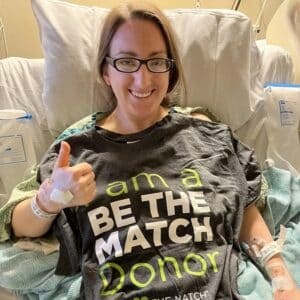Volume 38 Number 3 | June 2024
Kate DeAngelo, MLS(ASCP)CM, ASCLS Today Volunteer Contributor


Kate DeAngelo feeling great after a successful bone marrow donation.
In January 2023, I completed an in-depth health questionnaire and blood work to determine if I was the best match through Human Leukocyte Antigen (HLA) matching. Having an HLA matched donor and recipient is important because it increases the likelihood of having a successful transplant. After 60 days of patiently waiting, I was selected as the primary bone marrow donor for this child. At that time, he wasn’t ready to move forward with the transplant process due to a number of reasons. I began to move on with my day-to-day life after receiving the news that my dream of becoming a donor was brought to a halt. Three weeks later, I received a call that the patient was ready to move forward with the donation process, and September 21 was chosen as the donation day in San Diego, California.
A bone marrow donation isn’t the type of procedure that all hospitals can accommodate. A donation facility is chosen based on availability and donation type (bone marrow vs. peripheral stem cells). The bone marrow or peripheral stem cells are then shipped to where the patient resides. At the end of July, I flew down to San Diego to complete a physical exam and extensive blood work at the donation facility. I received a call shortly after returning to Idaho that the donation was put on hold due to the patient completing another round of chemotherapy. As a result, November 16 was chosen as the new donation date. At the end of October, the patient had an adverse reaction, and the donation was put on hold once again. The donation was bumped to December 28. As the donation date grew closer, I turned to the Facebook donor support group to prepare myself for the procedure. I learned quite a bit from other donors, but I remained nervous about the surgical and recovery process.
For this procedure, I was put under general anesthesia and flipped onto my stomach. Two doctors worked in tandem to collect the marrow from the back of my pelvis. A total of 1.4 liters of marrow was removed from my pelvic cavity. The volume of marrow removed from the donor is based on the donor’s size and patient’s needs. On the morning of donation, my hemoglobin was 14.3 g/dl. After a successful two-hour long procedure, my hemoglobin dropped to 10.0 g/dL. I felt very weak from the significant hemoglobin drop and groggy from the anesthesia. I realized this was going to be a longer and tougher recovery than I originally thought. Due to the volume of marrow that was taken, I had to spend the night in the hospital. It was a rough night because my lower back was tender and sore, making sleep hard to come by. The next morning, the doctor removed the pressure bandage to check the four incisions. Below the incisions were many punctures on the pelvis due to the doctors repositioning and reinserting the collection needles into the pelvic cavity. Since there was no sign of infection or major bleeding, the pressure bandage was replaced with four band-aids.
“I feel extremely honored and privileged to make a difference in this child’s life. I hope he can have a cancer-free childhood and live a long fulfilling life.”
It was difficult for me to take a step back from my very active lifestyle. I’ve run over 20 half marathons in and out of the country. Due to my back muscles being damaged from the procedure, mobility was challenging. It took several weeks for my back muscles to heal. As an athlete, I understood the importance of nutrition and appropriate exercise for successful rehabilitation. I remained anemic for several weeks post donation, but my body adapted quite well as I started regaining my strength. The bone marrow took about one month to fully regenerate, and my hemoglobin eventually returned to a normal level. I’m back to living the active lifestyle I had before donating with no complications.
The patient received my bone marrow on December 29, 2023. In due time, I will hear about his progress and potentially meet the family. I feel extremely honored and privileged to make a difference in this child’s life. I hope he can have a cancer-free childhood and live a long fulfilling life. Please consider adding your name to the Be the Match registry.
Note: Be The Match has recently rebranded to the National Marrow Donor Program (NMDP) with the same mission. All expenses are covered for you and a companion. All it takes is a cheek swab for you to get started. Visit the NMDP website for more information.
Kate DeAngelo is a generalist at St. Luke’s Magic Valley in Twin Falls, Idaho.